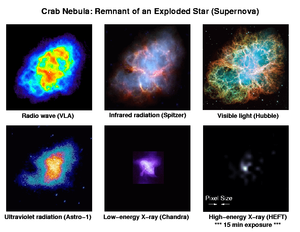Portal:Radiation astronomy/Intro

Radiation astronomy is astronomy applied to the various extraterrestrial sources of radiation, especially at night. It is also conducted above the Earth's atmosphere and at locations away from the Earth, by satellites and space probes, as a part of explorational (or exploratory) radiation astronomy.
Seeing the Sun and feeling the warmth of its rays is probably a student's first encounter with an astronomical radiation source. This will happen from a very early age, but a first understanding of the concepts of radiation may occur at a secondary educational level.
Radiation is all around us on top of the Earth's crust, regolith, and soil, where we live. The study of radiation, including radiation astronomy, usually intensifies at the university undergraduate level.
And, generally, radiation becomes hazardous, when a student embarks on graduate study.
Cautionary speculation may be introduced unexpectedly to stimulate the imagination and open a small crack in a few doors that may appear closed at present. As such, this learning resource incorporates some state-of-the-art results from the scholarly literature.
The laboratories of radiation astronomy are limited to the radiation observatories themselves and the computers and other instruments (sometimes off site) used to analyze the results.
